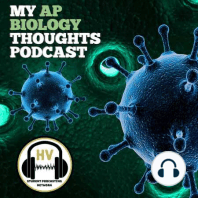6 min listen
Adaptive Radiation in Darwin's Finches
ratings:
Length:
4 minutes
Released:
Jan 20, 2021
Format:
Podcast episode
Description
My AP Biology ThoughtsEpisode #13Welcome to My AP Biology Thoughts podcast, my name is Chloe and I am your host for episode 13 called Unit 7 Evolution: Adaptive Radiation in Darwin's Finches. Today we will be discussing the diversification of the mainland species of finches due to adaptive radiation. Segment 1: Introduction to Adaptive Radiation in Darwin's FinchesIt’s important to understand what this all means. Adaptive radiation is a process in which organisms diversify rapidly from an ancestral species into a variety of new forms. A change in environment can introduce a species to new available resources, and can open new environmental niches. These openings cause new competition within the species, eventually leading to a certain trait being more advantageous. This ties in perfectly with the natural selection mechanism which describes the relationship between overpopulation, variation, competition, fitness, reproduction . The widespread of niches on the Galapagos makes a perfect fit for this mechanism to take place, and for rapid speciation to occur. This brings us right to the important stuff, the finches. The theory is that a small population of mainland finches migrated to each of these islands with different niches, creating competition for a certain type of resource. Variation caused one particular trait to be more beneficial than others, causing rapid speciating among these populations Segment 2: Example of Adaptive Radiation in Darwin's FinchesThe finches varied in beak sizes and fur color. Larger beaks were beneficial in niches where the available food source mostly consisted of large, difficult to open nuts while Smaller and thinner beaks were beneficial where the main source of food was insects because their small beak made it easier to prey on small bugs. This made it easy for competition to take its route, and let the finch that is more fit for the specific food source to survive and reproduce. Segment 3:Digging Deeper into Adaptive Radiation in Darwin's FinchesTo dig in deeper, it’s important to realize how this information is still relevant. This observation that Darwin made gave him evidence for his theory of natural selection that we still use today. The natural selection mechanism that we study still continues to cause organisms to evolve and speciate. Another important concept to this specific example of adaptive radiation is the divergent evolution that occurred, and how each population became a new species due to the available resources. Biogeography also helped Darwin understand the relatedness of the finches on different islands because their closeness in geography helped prove that they were related in some way Thank you for listening to this episode of My AP Biology Thoughts. For more student-ran podcasts, make sure that you visit www.hvspn.com. Thanks for listening!
Released:
Jan 20, 2021
Format:
Podcast episode
Titles in the series (100)
Endotherms and Ectotherms by My AP Biology Thoughts
